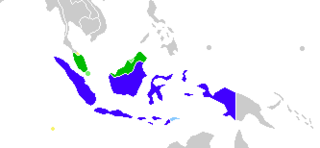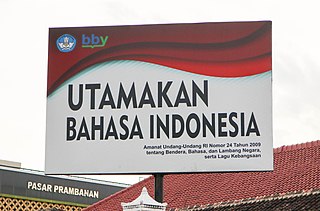Related Research Articles

Malay is an Austronesian language that is an official language of Brunei, Indonesia, Malaysia, and Singapore, and that is also spoken in East Timor and parts of Thailand. Altogether, it is spoken by 290 million people across Maritime Southeast Asia.

North Sulawesi is a province of Indonesia. It is mainly located on the Minahasa Peninsula of the island of Sulawesi, south of the Philippines and southeast of Sabah, Malaysia, but also includes various small archipelagoes situated between the Minahasa Peninsula and southern Philippines. It borders the Philippine province of Davao Occidental and Soccsksargen regions to the north, the Maluku Sea to the east, Gorontalo and the Celebes Sea to the west and the Gulf of Tomini to the southwest. The province's furthest extent, the outlying and isolated island of Miangas to its north, is the northernmost island of Indonesia as a bordering with the Philippines.
In addition to its classical and modern literary form, Malay had various regional dialects established after the rise of the Srivijaya empire in Sumatra, Indonesia. Also, Malay spread through interethnic contact and trade across the south East Asia Archipelago as far as the Philippines. That contact resulted in a lingua franca that was called Bazaar Malay or low Malay and in Malay Melayu Pasar. It is generally believed that Bazaar Malay was a pidgin, influenced by contact among Malay, Hokkien, Portuguese, and Dutch traders.

The Minahasans or Minahassa are an indigenous ethnic group from the North Sulawesi province of Indonesia, formerly known as North Celebes. The Minahasa people sometimes refer to themselves as Manado people. Although the Minahasan pre-Christian creation myth entails some form of ethnic unification, before the nineteenth century the Minahasa region was in no way unified. Instead, a number of politically independent groups (walak) existed together, often in a permanent state of conflict.

Manado is the capital city of the Indonesian province of North Sulawesi. It is the second largest city in Sulawesi after Makassar, with the 2020 census giving a population of 451,916, and the official estimates for mid 2023 showing 458,582 inhabitants, distributed over a land area of 157.26 km2. The Manado metropolitan area had a population of 1,377,815 as of mid 2023. The city is situated on the Bay of Manado, and is surrounded by a mountainous area.
Manado Malay, or simply the Manado language, is a creole language spoken in Manado, the capital of North Sulawesi province in Indonesia, and the surrounding area. The local name of the language is bahasa Manado, and the name Minahasa Malay is also used, after the main ethnic group speaking the language. Since Manado Malay is used primarily for spoken communication, there is no standard orthography.

A Dutch creole is a creole language whose main lexifier is the Dutch language, a West Germanic language of the Low Countries. These creoles usually developed from Dutch-based pidgins or through language mixing where Dutch served as a major influence.

Gerungan Saul Samuel Jacob Ratulangi, known as Sam Ratulangi, was a Minahasan teacher, journalist, politician, and national hero from North Sulawesi, Indonesia. He was part of the committee that ratified the Constitution of Indonesia and served as the first Governor of Sulawesi.

Kolintang is a traditional Minahasan percussion instrument from North Sulawesi, Indonesia, consisting of wooden blades arranged in a row and mounted on a wooden tub. Kolintang is usually played in ensemble music. Kolintang in the Minahasan community is used to accompany traditional ceremonies, dance, singing, and music. The wood used to make Kolintang blades is light but strong local wood such as Telur wood, Wenuang wood, Cempaka wood, Waru wood, and the like which have a fiber construction. parallel. Meanwhile, kolintang resonator crates are usually made of hardwood materials such as teak or mahogany.

Indonesia is home to over 700 living languages spoken across its extensive archipelago. This significant linguistic variety constitutes approximately 10% of the world’s total languages, positioning Indonesia as the second most linguistically diverse nation globally, following Papua New Guinea. The majority of these languages belong to the Austronesian language family, prevalent in the western and central regions of Indonesia, including languages such as Acehnese, Sundanese, and Buginese. In contrast, the eastern regions, particularly Papua and the Maluku Islands, are home to over 270 Papuan languages, which are distinct from the Austronesian family and represent a unique linguistic heritage. The language most widely spoken as a native language is Javanese, primarily by the Javanese people in the central and eastern parts of Java Island, as well as across many other islands due to migration.
The Gorontalo language is a language spoken in Gorontalo Province, Sulawesi, Indonesia by the Gorontalo people. With around one million speakers, it is a major language of northern Sulawesi.

Malay Indonesians are ethnic Malays living throughout Indonesia. They are one of the indigenous peoples of the country. Indonesian, the national language of Indonesia, is a standardized form of Riau Malay. There were numerous kingdoms associated with the Indonesian Malays along with other ethnicities in what is now Indonesia, mainly on the islands of Borneo and Sumatra. These included Srivijaya, the Melayu Kingdom, Dharmasraya, the Sultanate of Deli, the Sultanate of Siak Sri Indrapura, the Riau-Lingga Sultanate, the Sultanate of Bulungan, Pontianak Sultanate, and the Sultanate of Sambas. The 2010 census states that there are 8 million Malays in Indonesia; this number comes from the classification of Malays in East Sumatra and the coast of Kalimantan which is recognized by the Indonesian government. This classification is different from the Malaysia and Singapore census which includes all ethnic Muslims from the Indonesian archipelago as Malays.
The Minahasan languages are a subgroup of the Austronesian languages spoken by the Minahasa people in northern Sulawesi, Indonesia. They belong to the Philippine subgroup.

Minahasa Regency is a regency in North Sulawesi, Indonesia. Its capital is Tondano. It covers an area of 1,141.64 km2 and had a population of 310,384 at the 2010 Census; this rose to 347,290 at the 2020 Census, and the official estimate as at mid 2023 was 351,920.
Tombulu, also known as Minahasan language, is an Austronesian language of northern Sulawesi in Indonesia. It is a Minahasan language, a sub-group of the Philippine languages.

Tontemboan is an Austronesian language, of northern Sulawesi, Indonesia. It is a Minahasan language, a sub-group of the Philippine languages.
Negeri Sembilan Malay is an Austronesian language spoken mainly in the Malaysian state of Negeri Sembilan, including Alor Gajah and parts of Jasin District in northern Malacca, and parts of Segamat District in the northernmost part of Johor. The language is spoken by the descendants of Minangkabau settlers from Sumatra, who have migrated to Negeri Sembilan since as early as the 14th century. It is often considered a variant or dialect of the Minangkabau language; lexical and phonological studies, however, indicate that it is more closely related to Standard Malay than it is to Minangkabau.
Gorap is a Malay-based creole language predominantly spoken by Gorap (Bobaneigo) ethnic group, indigenous to western and northern regions of the Indonesian island of Halmahera. It shares vocabulary with other Papuan languages and some of languages spoken in Sulawesi, such as Buginese and Cia-Cia. Roughly around 60 out of 200 attested words in this language were indicated sharing vocabulary with those languages.

Bernard Wilhelm "B. W." Lapian was a nationalist involved in the struggle for Indonesian independence. He published several newspapers that gave voice to the welfare of the Indonesian people and promoted Indonesian nationalism. He was also part a group who established a separate Christian denomination from the official Dutch East-Indies church institution. After Indonesia gained its independence, Lapian served as head of the district of Manado and acting governor of Sulawesi. In 2015, he was given the title of National Hero of Indonesia by President Joko Widodo.

Dra. Augustine Magdalena Waworuntu, was an Indonesian politician who became the first post-federal Indonesian mayor of Manado and the first female mayor of Manado.
References
- 1 2 3 Frs, N. Raymond (2019-04-27). "Orang Borgo Manado, Sulawesi Utara". indonesiana.id (in Indonesian). Indonesiana. Retrieved 2024-09-24.
- ↑ Sompotan, Henny E. (2024-05-23). Sambeka, Bobby (ed.). "Asal Usul Etnik Borgo di Manado Sulawesi Utara". rri.co.id (in Indonesian). Radio Republik Indonesia . Retrieved 2024-09-24.
- ↑ "Sejarah Raja-Raja di Sulawesi Utara". sulut24.com (in Indonesian). Sulut 24. 2019-06-20. Retrieved 2024-09-24.
- ↑ Rompis, Arthur (2022-12-19). Savitri, Isvara (ed.). "Kisah Etnis Borgo: Bahasa Melayu Manado Disusun dari Puluhan Kata Portugis, Spanyol, dan Belanda". manado.tribunnews.com (in Indonesian). Tribun News . Retrieved 2024-09-24.
- ↑ Octavianus, Norman (2023-03-08). Ilat, Fabyan (ed.). "Kisah Etnik Borgo di Manado, Kawin Campur 1 Abad dan Pengaruhi Karakter Orang Sulawesi Utara". manado.inews.id (in Indonesian). iNews . Retrieved 2024-09-24.
- ↑ Najoan, J.A. Karisoh; Liwoso, M.A.; Djojosuroto, Kinajati; Kembuan, L. (1981). Morfologi dan Sintaksis Bahasa Melayu Manado (in Indonesian). Jakarta: Pusat Pembinaan dan Pengembangan Bahasa, Departemen Pendidikan dan Kebudayaan Republik Indonesia. Retrieved 2024-09-24.